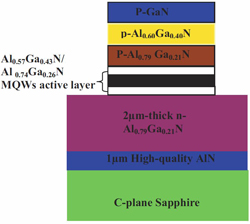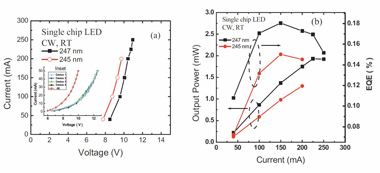
| Home | About Us | Contribute | Bookstore | Advertising | Subscribe for Free NOW! |
| News Archive | Features | Events | Recruitment | Directory |
News
15 February 2010
Deep ultraviolet power boost at shorter wavelengths
Researchers at Sensor Electronic Technology (SET) of Columbia, SC, USA have achieved a record 2mW of light output power in light-emitting diodes (LEDs) emitting wavelengths less than 250nm [W. Sun et al, Appl. Phys. Lett., vol96, p061102, 2010]. Efficiency droop effects were also investigated in the 245–247nm wavelength deep-ultraviolet LEDs (DUV, less than 300nm wavelength) based on the aluminum gallium nitride (AlGaN) semiconductor material system.
One of the contributors to the work, Dr Michael Shur, who is also Patricia W. and C. Sheldon Roberts Professor at Rensselaer Polytechnic Institute, comments: “SET has been breaking its own records for the last 5 years for all wavelengths shorter than 340nm and remains the sole commercial supplier of UV LEDs with peak emission wavelength shorter than 350nm. The company has already developed its next generation of large-area devices with significantly higher output power [M. Shatalov et al, 227–330nm deep UV LEDs, Proc. Abstr. 8th ICNS, Paper BB2, October 2009].”
DUV LED application possibilities include gas sensing, biodetection, disinfection, and photolithography. SET already offers DUV LED sources (400–240nm) and equipment based on these devices for air and water sterilization, and fluorimeters/spectrometers. These applications will be enhanced as DUV LEDs achieve increased output power, efficiency and reliability. As usual with nitride devices, material quality is a leading concern. Additional ‘issues’ concern the p-type doping of AlGaN, optimizing DUV light extraction, and general fabrication improvements.
SET has patented a proprietary migration-enhanced metal-organic chemical vapor deposition (MEMOCVD®) that, combined with conventional MOCVD, it uses to produce its nitride devices. The MEMOCVD technique is based on controlling the duration and waveform of the precursor pulses. The pulses of different precursors may even overlap. This allows the growth temperature to be reduced, giving improved atomic incorporation, surface coverage and thickness uniformity.
MEMOCVD has been shown to improve AlGaN material quality up to 0.75 Al molar fraction. Previously, 275–280nm multi-quantum well (MQW) UV LEDs produced with MEMOCVD/MOCVD achieved continuous wave (cw) output power of more than 1mW with a current of 20mA, exhibiting internal quantum efficiencies (IQEs) of 25–75% at room temperature. In December, SET reported 30mW cw from a 273nm UV-C single LED at 700mA (with a forward voltage of 6.5V) with an estimated lifetime of more than 3000 hours.
 Figure 1: Schematic of AlGaN-based 245nm UVLED.
Figure 1: Schematic of AlGaN-based 245nm UVLED.
In the latest work, SET used its techniques to produce large-area LEDs emitting shorter wavelengths of 245–247nm (Figure 1). Such short wavelengths usually require small-area bar (0.011mm2) or H-bar (0.035mm2) structures that allow for an optimized combination of heat sinking and light extraction compared to other shapes of deep UV LED. SET has a patent application pending for this technology.
However, it is advantageous to create larger-area devices. Large-area blue LED devices produce higher power by reducing the operating voltage and current density, avoiding self-heating effects. For SET’s new DUV LEDs, a large-area device has enabled the output power for cw operation to be increased to a record 2mW (247nm, 225mA) for the sub-250nm range (Figure 2). The area is a 12x increase on a typical bar design. The geometry of the devices was a 2x2 array of H-shape mesas constituting a single 650μm x 650μm four-pixel device. The chips were assembled into TO-39 packages. Bar-design devices were also produced for comparison purposes.

Figure 2: Current–voltage (I-V, a) and light output power (L–I, b) characteristics and EQE of 245nm and 247nm UV LEDs in cw operation. Inset: I–V characteristics of individual pixels and all four parallel pixels connected in parallel.
The external quantum efficiencies (EQEs) of more than 0.15% and 0.18% at 150mA for 247nm and 245nm devices, respectively, are also claimed as records. The output increases in a linear fashion up to about 200mA. Beyond that the power saturates, an effect attributed to self-heating because the EQE peaks at 150mA (~30mA/cm2), before power saturation.
Pulsed operation to reduce/eliminate self-heating of H and bar devices shows a higher peak in EQE at higher current density (~800A/cm2 for bar, ~450A/cm2 for H), so self-heating is not the only source of droop. Some of the usual suspects from the efficiency droop in InGaN green LEDs may also play a role here: Auger recombination, spillover, etc.
See related items:
SET wins $500,000 SBIR award from NSF to advance deep UV LEDs
SET claims record performance for large-area single-chip deep UV LEDs
![]() Search: Sensor Electronic Technology LEDs Deep-ultraviolet LEDs AlGaN
Search: Sensor Electronic Technology LEDs Deep-ultraviolet LEDs AlGaN
Visit: www.s-et.com
Visit: http://link.aip.org/link/?APPLAB/96/061102/1
The author Mike Cooke is a freelance technology journalist who has worked in the semiconductor and advanced technology sectors since 1997.